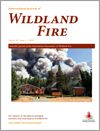International Journal of Wildland Fire
Volume 28
Number 11 2019
We evaluated the use of very-low-density airborne LiDAR data to assess potential fire behaviour in a Mediterranean forest. Our goal was to deliver a simple and manager-oriented approach to target high-hazard stands for silvicultural interventions based on readily available metrics without having to turn to advanced simulation modelling.
This study used unmanned aerial vehicles to produce disturbance-based land cover maps at 5- and 1-m resolutions with high overall accuracies (5 m, 89.5 ± 1.4%; 1 m, 85.4 ± 1.5%). The reduction in accuracy at the 1-m resolution was outweighed by the inclusion of four additional classes, which increased the thematic detail.
We used machine learning to classify ignition events as leading to small, medium or large fires. Using only two variables, we show that fires can be classified into three size groups with 50% accuracy. This simple framework for fire size prediction may be useful for fire management given limited resources.
Prescribed fire is an important land management tool that is not being applied at the desired levels. We investigated the role of policy barriers in constraining practice and current strategies in use to increase prescribed fire application on US federal lands.
Planning for and responding to wildland fires require assessment of the potential impacts, which is generally difficult to do. An easily implemented expert elicitation approach for quantifying the potential impacts on resources and assets was developed, applied and validated.
This article uses a unique dataset from 35 wildland–urban interface communities in Nevada to analyse how a homeowner’s decision to undertake a generic fire-safe investment is different than their decision to perform the suite of fire-safe investments necessary to create adequate defensible space on their property.





